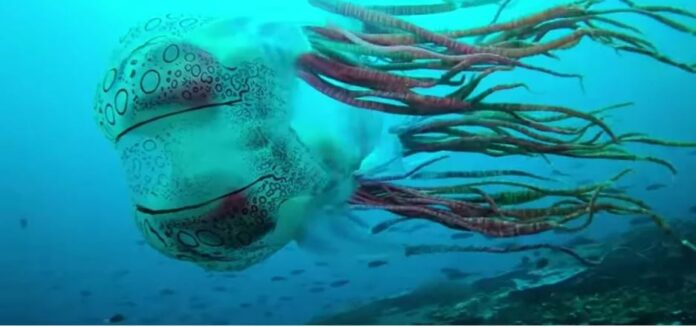In a stunning discovery off the coast of Queensland, Australia, marine biologists have documented an extraordinarily rare sighting of Chirodectes maculatus, a peculiar box jellyfish nicknamed the “soccer ball jellyfish” for its distinctive black-spotted, spherical appearance. This marks only the second confirmed sighting of the species in history, with the first recorded over three decades ago in 1990. The find has sent ripples of excitement through the scientific community, shedding light on one of the ocean’s most elusive creatures.
The sighting occurred during a routine underwater survey near the Great Barrier Reef, when divers noticed an unusual, translucent creature pulsating through the water. Measuring roughly the size of a soccer ball, Chirodectes maculatus is characterized by its hexagonal, spot-covered bell and long, trailing tentacles. Unlike its more notorious box jellyfish cousins, this species is not believed to pose a significant threat to humans, though researchers caution that little is known about its behavior or venom.
One of the rarest animal sightings in the world: chirodectes maculatus, only seen once beforepic.twitter.com/OBPw9I907U
— Massimo (@Rainmaker1973) April 19, 2025
Dr. Emily Carter, lead marine biologist on the expedition, described the encounter as “a once-in-a-lifetime moment.” “This jellyfish is so rare that we know almost nothing about its life cycle, habitat, or ecological role,” she said. “Each sighting is a precious opportunity to learn more about the mysteries of the deep.”
The discovery underscores the vast unknowns of marine biodiversity, particularly in the Pacific Ocean, where deep-sea exploration continues to reveal new species. Scientists are now analyzing footage and samples to better understand Chirodectes maculatus and its place in the ecosystem. Conservationists also highlight the importance of protecting fragile marine habitats like the Great Barrier Reef, which face threats from climate change and pollution.
This remarkable find serves as a reminder of the ocean’s hidden wonders, waiting to be explored. As research continues, the “soccer ball” jellyfish remains a symbol of nature’s enduring mysteries.
Key Points:
Species: Chirodectes maculatus, a rare box jellyfish dubbed the “soccer ball jellyfish” due to its black-spotted, spherical bell.
Sighting: Only the second confirmed sighting ever, spotted off Queensland, Australia, near the Great Barrier Reef during a routine underwater survey.
First Record: Initially documented in 1990; this is the first sighting in over 30 years.
Characteristics: Translucent, soccer ball-sized, with hexagonal spots and long tentacles; not believed to be highly dangerous to humans.
Scientific Significance: Offers a rare chance to study an elusive species about which little is known, including its life cycle, habitat, and ecological role.
Research Efforts: Marine biologists are analyzing footage and samples to learn more about the species.



